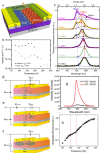Review on Perovskite Semiconductor Field-Effect Transistors and Their Applications
- PMID: 35889621
- PMCID: PMC9322712
- DOI: 10.3390/nano12142396
Review on Perovskite Semiconductor Field-Effect Transistors and Their Applications
Abstract
Perovskite materials are considered as the most alluring successor to the conventional semiconductor materials to fabricate solar cells, light emitting diodes and electronic displays. However, the use of the perovskite semiconductors as a channel material in field effect transistors (FET) are much lower than expected due to the poor performance of the devices. Despite low attention, the perovskite FETs are used in widespread applications on account of their unique opto-electrical properties. This review focuses on the previous works on perovskite FETs which are summarized into tables based on their structures and electrical properties. Further, this review focuses on the applications of perovskite FETs in photodetectors, phototransistors, light emitting FETs and memory devices. Moreover, this review highlights the challenges faced by the perovskite FETs to meet the current standards along with the future directions of these FETs. Overall, the review summarizes all the available information on existing perovskite FET works and their applications reported so far.
Keywords: field effect transistor; light-emitting FET; mobility; perovskite; photo detector.
Conflict of interest statement
The authors declare no conflict of interest.
Figures














References
-
- Deschler F., Neher D., Schmidt-Mende L. Perovskite semiconductors for next generation optoelectronic applications. APL Mater. 2019;7:7–10. doi: 10.1063/1.5119744. - DOI
-
- Fu Y., Zhu H., Chen J., Hautzinger M.P., Zhu X.Y., Jin S. Metal halide perovskite nanostructures for optoelectronic applications and the study of physical properties. Nat. Rev. Mater. 2019;4:169–188. doi: 10.1038/s41578-019-0080-9. - DOI
-
- Rhee S., An K., Kang K.T. Recent advances and challenges in halide perovskite crystals in optoelectronic devices from solar cells to other applications. Crystals. 2021;11:39. doi: 10.3390/cryst11010039. - DOI
Publication types
LinkOut - more resources
Full Text Sources

